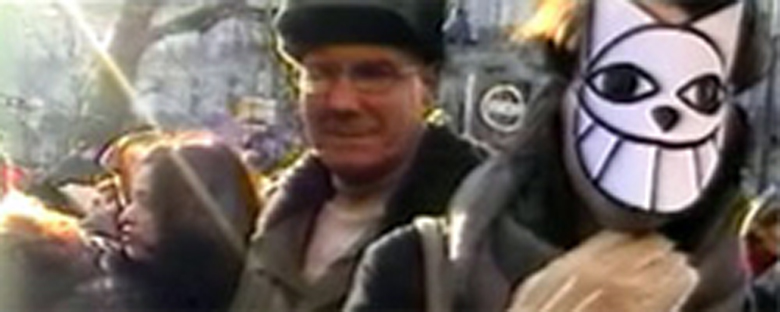Reviews
Chats perchés
Chris Marker
France, 2004
Credits
Review by Jenny Jediny
Posted on 01 May 2006
Source Films du Jeudi Video
Related articles
Features: The 5th Annual Tribeca Film Festival
Imagine if Churchill had demanded that Hitler leave Germany within 48 hours?
Chris Marker’s sly and charmingly playful The Case of the Grinning Cat asks that very question of George W. Bush on the evening of March 17th, 2002, after hearing Bush’s promise to invade Iraq if Saddam Hussein would not give himself up within the allotted time frame. Of course, it is punctuated with a grinning, yellow Cheshire cat. Marker’s affinity for felines is long established, from the portraits of cats he uses so frequently to stand in for his own anonymous portrait to the humorous segment in Sans Soleil devoted to a Japanese temple consecrated to cats. According to our narrator, painted yellow cats began to appear on building walls in November of 2001, their wide grins attracting notice as they appeared to have neither a visible source nor an indicated meaning. Marker seeks out and videotapes the images, provides running commentary on local Parisian felines, and integrates the developing war in Iraq and its subsequent protest in France.
A brief 58 minutes in length, The Case of the Grinning Cat premiered on French television in 2004, with Marker completing the English language version only recently. The search for identity, so often the connecting thread in Marker’s work, feels fleshed out here with the persistent questioning of the feline’s appearance in the changing emotional climate of France during late 2001-2002. The cat’s appearance seems to have struck an inspirational note for Marker (although he indicates that he was one of many Parisians to appreciate the cat), prompting curiosity, but also a sense of comfort and resolve following the low morale in France after September 11th. Pursuing the cat, Marker soon finds the image prevalent in political activism, as he spots it on television in student demonstrations. These protests become a key focus in the film, as they escalate and extend beyond Iraq to domestic French elections and local union protests. Marker blends in the television news excerpts exceptionally well, utilizing video editing to give still frames of politicians a rather wobbly and fuzzy effect, enhancing the absurdity of their speech. Although it is evident that Marker has liberal sensibilities, it is in juxtaposing these world leaders against the mass of student protestors that we see the related hypocrisy between the seemingly opposed groups. Although it is evident that protest is alive and well in France (noting the recent success of student protests there regarding labor laws), Marker maintains a critical stance, questioning the reappropriation of the past for political purpose, as conservative students amusingly adopt a Communist writer’s poem in their protest against Union workers.
Is protest and related forms of activism vital, as it so urgently seemed in May of ‘68, or is it now simply in vogue? Marker’s weaving of history, at first facetious in tone (Marker places the grinning cat within historical canons, finding it in everything from a Picasso to a postal stamp) becomes skeptical—Marker asks how many May Days will have to pass before he ceases to see history repeat itself. While remaining an observant eye, Marker returns to and finds solace in the mystery cat and its enigmatic grin—unlike the fluctuating politicians and protestors, cats are consistent, and for that, Marker gives thanks (Merci les chats). With a few poignant moments (mainly the near tragedy of a Metro cat catching its paw in an escalator—she survived) The Case of the Grinning Cat mainly finds the 84-year-old director standing back and merely shaking his head (and rolling his eyes) at the political and global debacles before him.
We don’t do comments anymore, but you may contact us here or find us on Twitter or Facebook.



